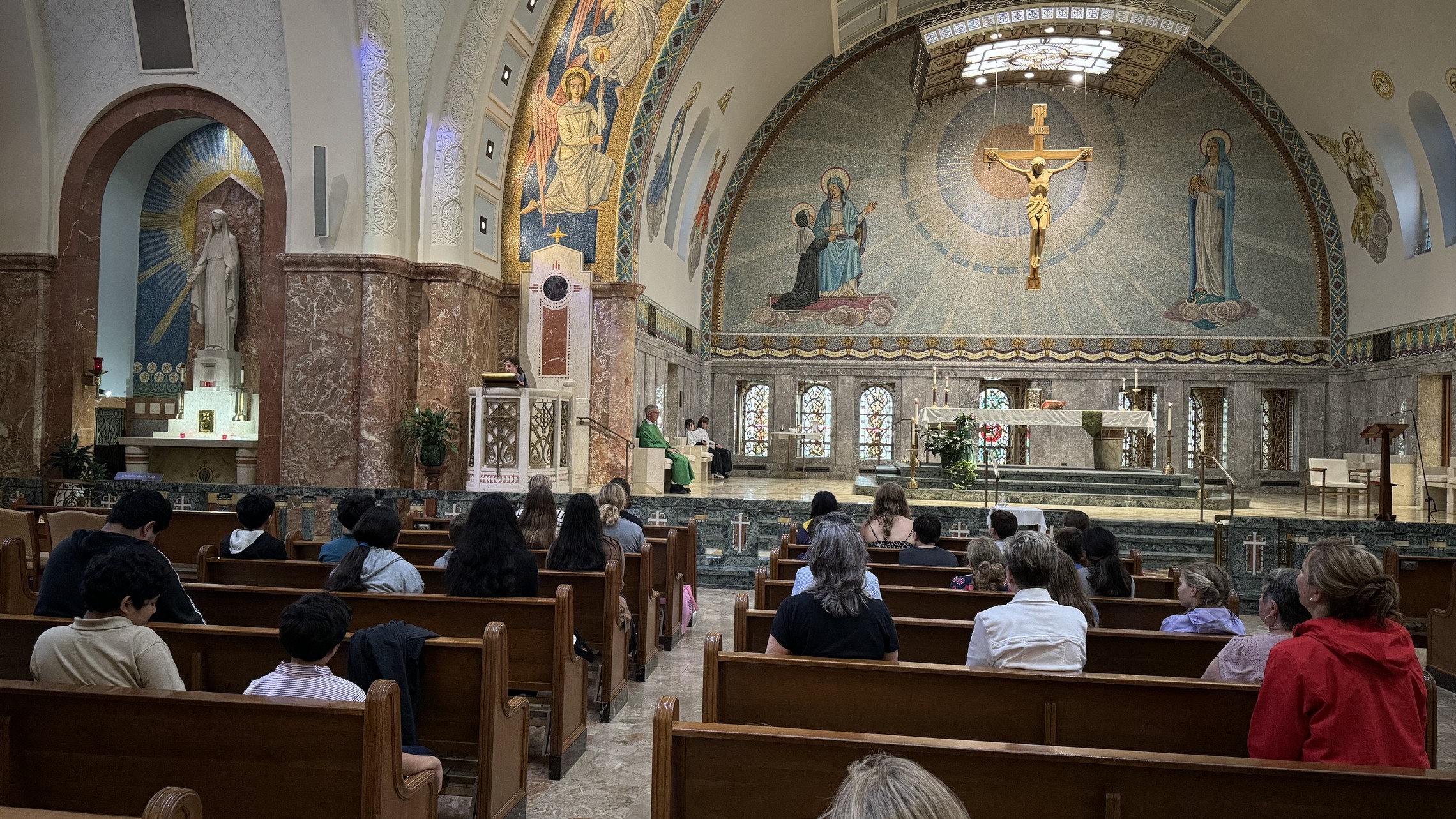THE PENANCE OF RALPH NORWICH

A Lenten Short Story by Fr. Edlefsen
The Penance of Ralph Norwich
A Short Story by Fr. Frederick Edlefsen
Ralph Norwich gave up bubble gum for Lent in 1953. It was an odd thing to do because he didn’t believe in God. Odder yet, he was in fourth grade. Odder yet, he attended St. Aloysius Catholic School in Waldham, New Jersey. Here are some things you need to know about Ralph’s life.
Waldham was boring. St. Aloysius was boring, except for Bingo. The nuns were nondescript, like milk toast. They wore black habits, black veils and white wimples, like most nuns in the 1950s, including Ingrid Bergman. They were a small community known as The Franciscan Sisters of Waldham. They were an offshoot of The Franciscan Sisters of Uniontown (Pennsylvania), established to cover what the Uniontown sisters called the “Waldham mission.” St. Aloysius had three priests. Monsignor Frank Wilton was Pastor. The two curates were Father Henry Jones and, the newbie, Father Mel Phillips. All three were terrible preachers. For example, Fr. Phillips’ said this in his first homily at St. Aloysius: “My dear brothers and sisters, children in Christ Jesus. All. My name is Father Mel Phillips. I just got here. I was ordained last week. I’m lucky to be here because I was a difficult delivery. That’s what mom said. I have four brothers, but I’m the only priest. Mom cried when I became a priest last week. Today, I want to talk about what Jesus did. Morality is very important. Jesus healed a blind man. The man can see now. Before that, he couldn’t see. When he could see, Jesus told the man not to tell anybody. But he told everybody. That was a sin. It was immoral. If someone tells you not tell anyone, then don’t…”
The week before Fr. Phillips arrived at St. Aloysius, Monsignor Wilton said this in his in his homily: “Next week we will have a new priest. His name is Father Mel Phillips. When he was born, he was a difficult delivery. So we’re lucky to have him. His mom cried when he was ordained. Father Phillips told me this. But I saw it myself. His mom was really crying. I bet Jesus was a difficult delivery. Ladies, can you imagine giving birth to the Son of God?”
No one complained. It was just part of living in Waldham. Mass was murmured in a language rumored to be Latin. The Fathers usually preached about morality and how it protected America from Communism. But Christmas and Easter were special. All three Fathers preached on the Gospel, or at least restated it. For example, Fr. Jones, whom no one either liked or disliked, said this at Christmas: “Jesus was born from the Virgin Mary, and she wrapped him in swaddling clothes. There was a big star in the sky, so the wise men were able to find Jesus. They came in and brought him gold, frankincense and myrrh. Mary, Joseph, shepherds and the drummer boy were all there. The baby Jesus didn’t cry, and the cattle were lowing…”
The Fathers were dispassionate but correct. They were sociable when the Dodgers and Yankees played on TV. They usually got invited to parishioners’ homes to watch baseball on black-and-white RCAs because most people in Waldham had roots in Brooklyn. The Fathers would drink Schlitz and smoke Chesterfields. After the games, Fr. Jones played the accordion while the ladies ate dessert and the men smoked cigars.
In Waldham, most Catholics, Presbyterians, Lutherans and Jews walked the straight and narrow, so most people assumed. The Methodists, however, were the reputed wheelers-and-dealers and two-timers. No one in Waldham – and only in Waldham – trusted the Methodists. That was because the pastor of the First United Methodist Church of Waldham, the Reverend Harlan Noone – originally from Kentucky – was also the local fast-talking Ford dealer. “Noone Ford” was the dealership’s name, with a big blue sign that said, “Honest as the Noone Day Sun.” The Fathers drove Chevys.
Every December 8, the Solemnity of the Immaculate Conception, was Pledge Sunday at St. Aloysius. Mass goers signed a pledge card promising not to watch bad movies. Ralph wondered about that. When his mom took the kids to watch Peter Pan, Ralph asked, “Mom, can we see a bad movie?”
At Christmas, there were always two trees in the church – one in the corner to the left of St. Joseph, and another in the corner to the right of Mary. A crèche was beneath the St. Aloysius Altar. On school’s last day before the Christmas break, an elderly Mr. Heinlein dressed as Santa Clause. He wore a modacrylic white beard with an elastic band – with tag that said “Union Carbide” – stretched around his head and a pillow stuffed under his red suit’s belly. He took toy orders from kids young enough to believe in Santa. Ralph was one of the few fourth graders who still believed in Santa and the only one who didn’t believe in God. Ralph only believed in what he saw. He saw Santa three times a year: first on school’s last day before Christmas; secondly at Gimbels department store which his mom said was about "courtesy, reliability, good value, and enlightened management;” and thirdly at Walgreen’s which was non-of-the-above.
For Lent, however, Ralph gave up bubble gum. But he took up Juicy Fruit. That was penitence for Ralph. Juicy Fruit ran out of flavor in under thirty seconds. He timed it. And he couldn’t blow bubbles. Moreover, he could swallow it if Sister Seraphim accused him of chewing in class. Unlike bubble gum, it wouldn’t sit in his stomach for seven years before dissolving. Sister Seraphim told her fourth graders that gum takes seven years to dissolve in the stomach – a solemn warning for anyone premeditating chewing gum in class and swallowing it if caught. You’re better off spitting it out and coming clean than have it sit in your belly for seven years. But Ralph was scientific. He noticed that when Juicy Fruit was left in the car on hot days, it became so soft, dissolved in the mouth and could be swallowed like saltwater taffy from Atlantic City. The only reason Ralph did any penance for Lent was because Sister Seraphim, whom his mother once said was a Franciscan Sister of Waldham, said they had to. Ralph respected Sister Seraphim, and all nuns, because of their habits and wimples. Like Santa, he could see them. Therefore, they had authority. Though he didn’t believe in God, he’d put 2 cents in a little basket passed around every Lent to raise money to baptize an African “pagan baby.” He thought it was good because the Sister, whom he could see, said so. After Easter, Sister showed the class a picture of their newly baptized ex-pagan babies. Ralph saw it, and that was good enough for him.
Sister believed in God. At least that’s what she said. So, why not Ralph? Sister taught him all subjects, including Religion and Polish, though Ralph was neither religious nor Polish. His classroom had a crucifix over the chalkboard. On the side wall, to the right of the desks, there was a world map with a bright, blue Poland in the dead center. Sister drilled into her fourth graders this question: “Why did God make me?” They repeated the correct answer: “To know Him, to love Him, and to serve Him.” But Ralph once asked Sister, “How do you know?” Sister answered, “Because He loves me.” “But how do you know He’s real?” Sister replied: “Because He loves me and I love Him.” Ralph scratched his red head and picked his red nose, in deep thought. He raised his hand again and asked, “Do you see him?” “No,” said Sister. Ralph replied: “Then how can He love you and you love Him if you don’t seem Him? How can you love someone you can’t see but who sees you?” He hoped she’d give him a good answer because he believed the Sister whom he did see and, yet, who believed in a God whom he didn’t see or believe in. Ralph once saw a license plate from Missouri that said, “Show Me State.” He thought it nifty. But now he questioned. Perhaps “seeing is not believing,” thought Ralph. This troubled him.
Little did Ralph know that Sister didn’t really believe in God. She became a nun because her dad picked her, from among six daughters, to join The Franciscan Sisters of Waldham. She was his smartest and prettiest daughter – his gift to God in thanksgiving for saving his Polish parents from Nazis and Communists, bringing them safely to Waldham in 1947. When Ralph was in the seminary, he got news that Sister Seraphim had left the convent in 1965 and that her real name was Zuzanna, or Suzie. She married the slick Methodist minister in ‘67, and some folks from St. Aloysius reported seeing her riding around Secaucus in a Mustang. She opened a yoga spa in ‘68. Gave it up in ‘71. Divorced the minister in ’74. Took to driving a Chevy. Got a job teaching Polish in a public school. She never remarried. She reverted to Catholicism in ’85, became a daily communicant in ’86 and started watching Mother Angelica in ‘87. She passed her spare time volunteering at a homeless shelter and at a hospice run by the Missionaries of Charity. She passed hours in silent prayer, meditating before the Blessed Sacrament. In March of 2006, she was dying of cancer. She wept and crossed herself when Father Ralph Norwich gave her the Last Rites, three hours before she died. It was Lent.
One afternoon in 1953, after the May crowning during the Easter Season, Sister Seraphim took her fourth grade class to church when the Blessed Sacrament was exposed. Ralph felt something. It went away. It came back in college. It vanished after ordination. But he persevered in the priesthood, unlike many convinced seminary classmates. But he “believed” again when he gave Sister Seraphim the Last Rites. Long, long ago he gave up bubble gum because Sister Seraphim said to. That was a good enough reason.
Categories:



